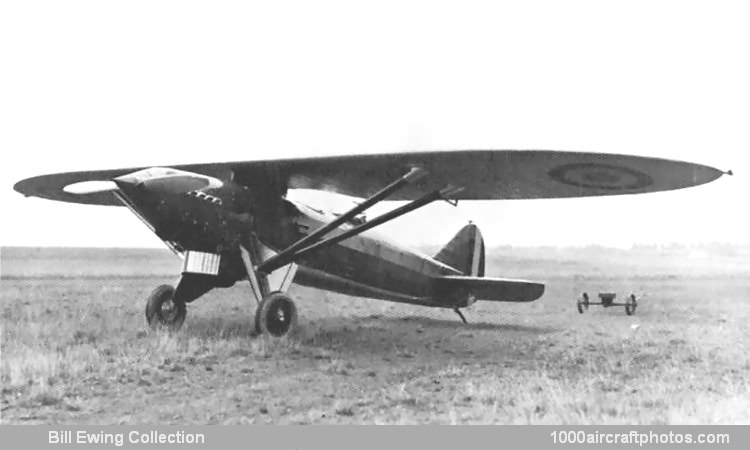A prerequisite in the design of such aircraft was a high-mounted wing in order to provide an adequately unobstructed downward view for the crew members, and reasonable short-field characteristics were desirable, but high performance and long endurance were considered unnecessary. A typical product of such thinking was the R.31 which, destined to be the sole aircraft of Belgian design and construction to see operational service during the eighteen days in which Belgian forces resisted the German invasion of their country, was designed by Alfred Renard of Constructions Aéronautiques G. Renard of Evère, near Brussels.
Designed to meet a requirement for a tactical reconnaissance and army co-operation aircraft for Belgium's Aéronautique Militaire, and flown for the first time at Evère on October 16, 1932, the R.31 was a parasol monoplane of metal construction with a Rolls-Royce Kestrel II.S twelve-cylinder liquid-cooled engine rated at 525 hp for take off and 480 hp at 11,811 ft (3,600 m).
The wing was a conventional two-spar arrangement with diagonal cross bracing in the form of a Warren truss, built in two sections, joined at the center line, and carried above the fuselage by faired vertical struts from the fuselage mainframes, and a single inclined V-strut on each side from the landing gear fairing to mid span.
The leading edges were covered by duralumin sheet and the remainder by fabric. The rectangular-section fuselage, which was faired to an oval, was covered forward by detachable light metal panels which also covered the upper and lower decking aft, the remainder being fabric covered. Apart from automatic slots along the inner halves of the wing leading edges, the R.31 had no high-lift devices, although the long-span ailerons also served as flaps.
In March 1934, an order for 28 machines was placed on behalf of the Aéronautique Militaire, and of these six were to be produced by the parent company and the remaining 22 by the Société Anonyme Beige de Constructions Aéronautiques (SABCA). The production R.31 differed little from the prototype, apart from the deletion of the Scarff ring gun mounting in the observer's cockpit, and the first aircraft were completed late in 1934, the second production aircraft being fitted with a 580 hp Lorraine Petrel twelve-cylinder liquid-cooled engine for comparison purposes, although this was later replaced by the standard Kestrel II.S.
During the course of 1935, the tenth production R.31 was modified by the fitting of a long "glasshouse" from the wing leading edge to the observer's cockpit, an extended vertical fin, and a Gnome & Rhône 14Krsd fourteen-cylinder radial air-cooled engine offering 1,065 hp for take off and 815 hp at 7,152 ft (2,180 m). With these modifications the aircraft was redesignated R.32. The Gnome & Rhône radial was then supplanted by an Hispano-Suiza 12Ydrs twelve-cylinder liquid-cooled engine of 830 hp for take off and 860 hp at 10,663 ft (3,250), but the R.32 did not display sufficient improvement over the R.31 to warrant a production order, and soon reverted to standard configuration.
In August 1935, a further six R.31s were ordered from Renard, and the first deliveries to the Aéronautique Militaire were made in the following December. The R.31 did not prove a popular aircraft with Aéronautique Militaire pilots. It was by no means an easy aircraft for a novice to fly. It was unforgiving and prone to developing a flat spin, and the pilots notes forbade all aerobatics. Provision was made for mounting one 0.30 in (7.62 mm) Vickers machine gun in a blister fairing on each side of the fuselage, but most production aircraft mounted only one gun on the starboard fuselage side, plus a 0.30 in (7.62 mm) Vickers "K" gun on a flexible mounting in the observer's cockpit.
The R.31s were issued to the 9e Escadrille "Sioux Bleu" (9/V/1) of the Ve Groupe of the 1er Régiment and the 11e Escadrille "Sioux Rouge" (11/V/1) of the VIe Groupe of the 1er Régiment, both of which units were based at Bierset, just west of Liège. All the R.31s escaped destruction on the ground by the Luftwaffe during the first attack on Bierset on May 10, 1940, but several aircraft that were undergoing overhaul or repair and could not be made airworthy quickly had to be left behind when the base was evacuated.
During the following seventeen days, the R.31s of the 9e and l1e Escadrilles flew 41 operational reconnaissance missions in support of the Allied forces, but the number of airworthy aircraft diminished rapidly as the units retreated from base to base, and the final mission, which was also destined to be the last mission flown by an aircraft of Belgium's Aéronautique Militiare during the German invasion of Belgium was flown in the late afternoon of May 27 from Steene, in the vicinity of Ostend."
